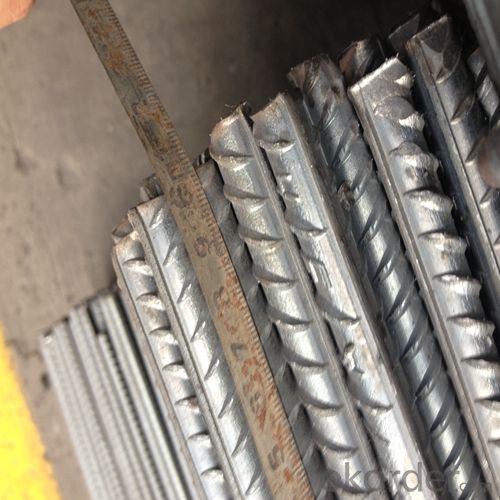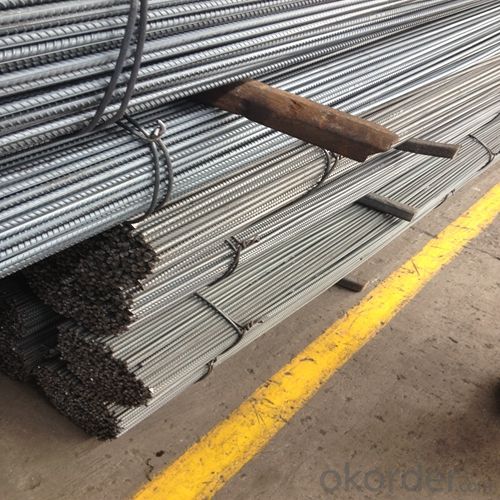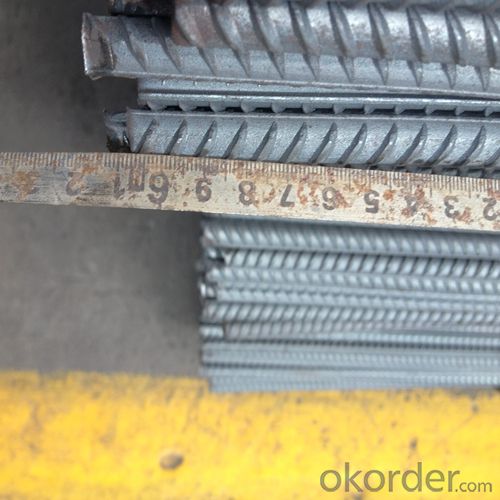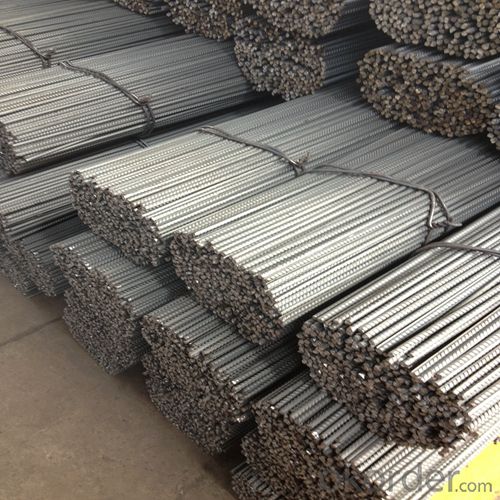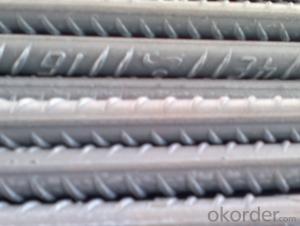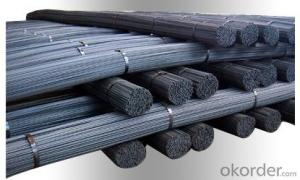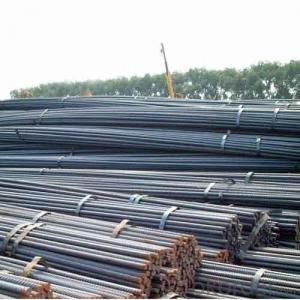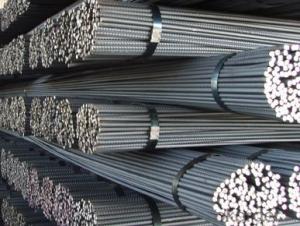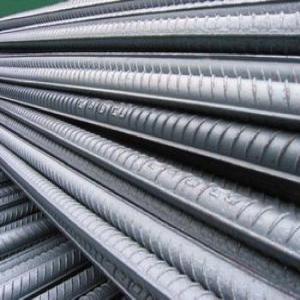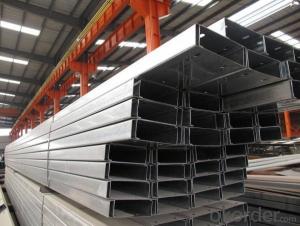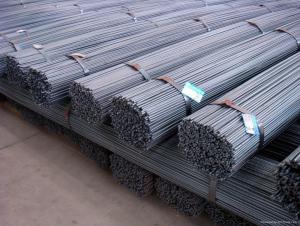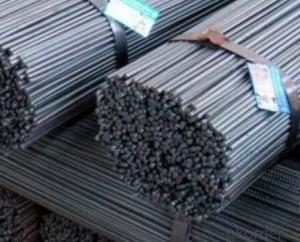Hot Rolled Steel Rebar Deformed Bar Made In China
- Loading Port:
- Tianjin
- Payment Terms:
- TT OR LC
- Min Order Qty:
- 2000 m.t.
- Supply Capability:
- 30000 m.t./month
OKorder Service Pledge
OKorder Financial Service
You Might Also Like
Product Description:
Specifications of Deformed Steel Bar:
Standard | GB | HRB335, HRB400, HRB500 | |
UK | G460B, B500A, B500B,B500C | ||
USA | GR40, GR60 | ||
Diameter | 6mm,8mm,10mm,12mm,14mm,16mm,18mm,20mm, 22mm,25mm,28mm,32mm,36mm,40mm,50mm | ||
Length | 6M, 9M,12M or as required | ||
Place of origin | Hebei, China mainland | ||
Application | building,construction,road,bridge etc | ||
Brand name | DRAGON | ||
Theoretical weight and section area of each diameter as below for your information:
Diameter(mm) | Section area (mm²) | Mass(kg/m) |
6 | 28.27 | 0.222 |
8 | 50.27 | 0.395 |
10 | 78.54 | 0.617 |
12 | 113.1 | 0.888 |
14 | 153.9 | 1.21 |
16 | 201.1 | 1.58 |
18 | 254.5 | 2.00 |
20 | 314.2 | 2.47 |
22 | 380.1 | 2.98 |
25 | 490.9 | 3.85 |
28 | 615.8 | 4.83 |
32 | 804.2 | 6.31 |
36 | 1018 | 7.99 |
40 | 1257 | 9.87 |
50 | 1964 | 15.42 |
Chemical Composition: (Please kindly find our chemistry of our material based on HRB500 as below for your information)
Grade | Technical data of the original chemical composition (%) | ||||||
C | Mn | Si | S | P | V | ||
HRB400 | ≤0.25 | ≤1.60 | ≤0.80 | ≤0.045 | ≤0.045 | 0.04-0.12 | |
Physical capability | |||||||
Yield Strength (N/cm²) | Tensile Strength (N/cm²) | Elongation (%) | |||||
≥400 | ≥570 | ≥14 | |||||
Usage and Applications of HRB400 Deformed Steel Bar:
Deformed bar is widely used in buildings, bridges, roads and other engineering construction. Big to highways, railways, bridges, culverts, tunnels, public facilities such as flood control, dam, small to housing construction, beam, column, wall and the foundation of the plate, deformed bar is an integral structure material. With the development of world economy and the vigorous development of infrastructure construction, real estate, the demand for deformed bar will be larger and larger..
Packaging & Delivery of HRB400 Deformed Steel Bar:
Packaging Detail: products are packed in bundle and then shipped by container or bulk vessel, deformed bar is usually naked strapping delivery, when storing, please pay attention to moisture proof. The performance of rust will produce adverse effect.
Each bundle weight: 2-3MT, or as required
Payment term: TT or L/C
Delivery Detail: within 45 days after received advanced payment or LC.
Label: to be specified by customer, generally, each bundle has 1-2 labels
Trade terms: FOB, CFR, CIF
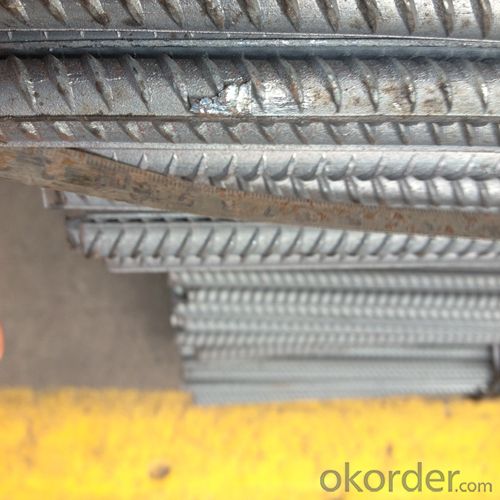

- Q: Can steel rebars be used in the construction of offshore oil platforms?
- Indeed, the inclusion of steel rebars is deemed feasible for the construction of offshore oil platforms. In construction practices, steel rebars are commonly employed to fortify concrete structures, thereby enhancing their strength and durability. In the context of offshore oil platforms, the use of steel rebars serves to fortify the concrete foundations and structures of the platform, facilitating its resistance against the adverse environmental conditions as well as the weight of the equipment and infrastructure situated on the platform. These steel rebars are engineered to withstand corrosion and are typically coated with epoxy or other protective coatings to prevent rusting within the corrosive marine environment. Additionally, steel rebars can be specifically tailored to meet the precise requirements of the offshore oil platform, thereby ensuring that they deliver the essential strength and stability.
- Q: Can steel rebars be used in railway bridge construction?
- Yes, steel rebars can be used in railway bridge construction. Steel rebars are commonly used in the construction industry for reinforcing concrete structures, including bridges. Railway bridges often require a high level of strength and durability to support heavy loads and withstand the constant vibrations and stresses caused by passing trains. Steel rebars provide the necessary reinforcement to concrete structures, enhancing their load-bearing capacity and ensuring the bridge's long-term structural integrity. Additionally, steel rebars can be easily customized to meet the specific design requirements of railway bridges, making them a suitable choice for construction in this context.
- Q: What are the different types of steel rebars used in dam construction?
- There are typically three types of steel rebars used in dam construction: carbon steel rebars, epoxy-coated rebars, and stainless steel rebars. Carbon steel rebars are the most commonly used type due to their high strength and cost-effectiveness. Epoxy-coated rebars are used in situations where corrosion resistance is crucial, as the coating helps protect the steel from exposure to moisture and chemicals. Stainless steel rebars are used in highly corrosive environments or where additional strength and durability are required.
- Q: How are steel rebars measured?
- Steel rebars are typically measured by their diameter and length. The diameter is commonly measured in millimeters or inches, while the length is measured in meters or feet.
- Q: How do steel rebars affect the overall strength of concrete structures?
- Steel rebars significantly enhance the overall strength of concrete structures by increasing their tensile strength, improving their resistance to cracking and deformation, and providing structural stability and reinforcement against external forces.
- Q: Are steel rebars prone to expansion and contraction?
- Yes, steel rebars are prone to expansion and contraction due to changes in temperature.
- Q: How is thread steel made?
- The billets used in continuous small mills are generally continuous billets, the length of which is usually 130~160mm, the length is about 6~12 meters, and the billets are 1.5~3 tons in weight. The rolling line is mostly flat interchange arrangement to realize all round rolling without torsion. According to different billet specifications and finished sizes, there are 18, 20, 22 and 24 small mills, 18 of which are mainstream. The use of bar rolling reheating furnace, high pressure water descaling, in addition to the new technology of low-temperature rolling, endless rolling, rolling, rolling development to adapt and improve the precision of rolling billet, rolling mill is mainly to improve the accuracy and speed (up to 18m/s). Product specifications are generally phi 10-40mm, Phi Phi 6-32mm or 12-50mm. The steel grades produced are low, medium and high carbon steels and low-alloy steels, which are widely needed in the market. The maximum rolling speed is 18m/s. The production process is as follows:Reheating furnace, roughing mill, rolling mill, rolling mill, water cooling device, cooling bed, cold shear, automatic counting device, bundling machine, unloading bench is calculated from the Shanghai kuanli Steel Co. Ltd. to provide thread steel weight: diameter * * outer diameter theory 0.00617=kg/m theory and 6.50.260 steel manufacturers specifications Jiuzheng 8.00.395 Jiuzheng steel 100.617 steel 120.888 steel 141.21 nine nine nine nine nine steel 161.58 steel 182 steel 202.47 steel 222.98 steel 253.85 nine nine nine nine nine steel 284.83 steel 326.31 steel.
- Q: How long do steel rebars last in structures?
- Steel rebars can last for several decades, typically around 50 to 100 years, when used in structures. However, their lifespan can be affected by various factors such as the quality of the rebar, environmental conditions, maintenance practices, and exposure to corrosive agents. Regular inspections and proper maintenance can significantly extend the lifespan of steel rebars in structures.
- Q: How do steel rebars affect the overall sound insulation of a building?
- The overall sound insulation of a building is not directly affected by steel rebars. Steel rebars serve to reinforce concrete structures and offer strength and stability in construction. Sound insulation is primarily determined by the materials and design of walls, floors, and ceilings, as well as the correct installation of acoustic barriers and insulation materials. Although steel rebars can transmit sound to a certain degree due to their density, their impact on sound insulation is usually insignificant when compared to other factors. To achieve sound insulation in buildings, it is necessary to utilize materials with excellent sound absorption properties, such as acoustic insulation panels, mineral wool, or soundproofing barriers.
- Q: How do steel rebars affect the overall fire rating of a building?
- Steel rebars can have a positive impact on the overall fire rating of a building. By reinforcing concrete structures, rebars can help enhance the fire resistance of the building. Steel has high melting and ignition temperatures, which means it can withstand heat and maintain its structural integrity for longer periods during a fire. This additional durability provided by rebars can help prevent structural collapse, allowing occupants more time to evacuate safely and aiding firefighters in their efforts to suppress the fire.
Send your message to us
Hot Rolled Steel Rebar Deformed Bar Made In China
- Loading Port:
- Tianjin
- Payment Terms:
- TT OR LC
- Min Order Qty:
- 2000 m.t.
- Supply Capability:
- 30000 m.t./month
OKorder Service Pledge
OKorder Financial Service
Similar products
Hot products
Hot Searches
Related keywords





